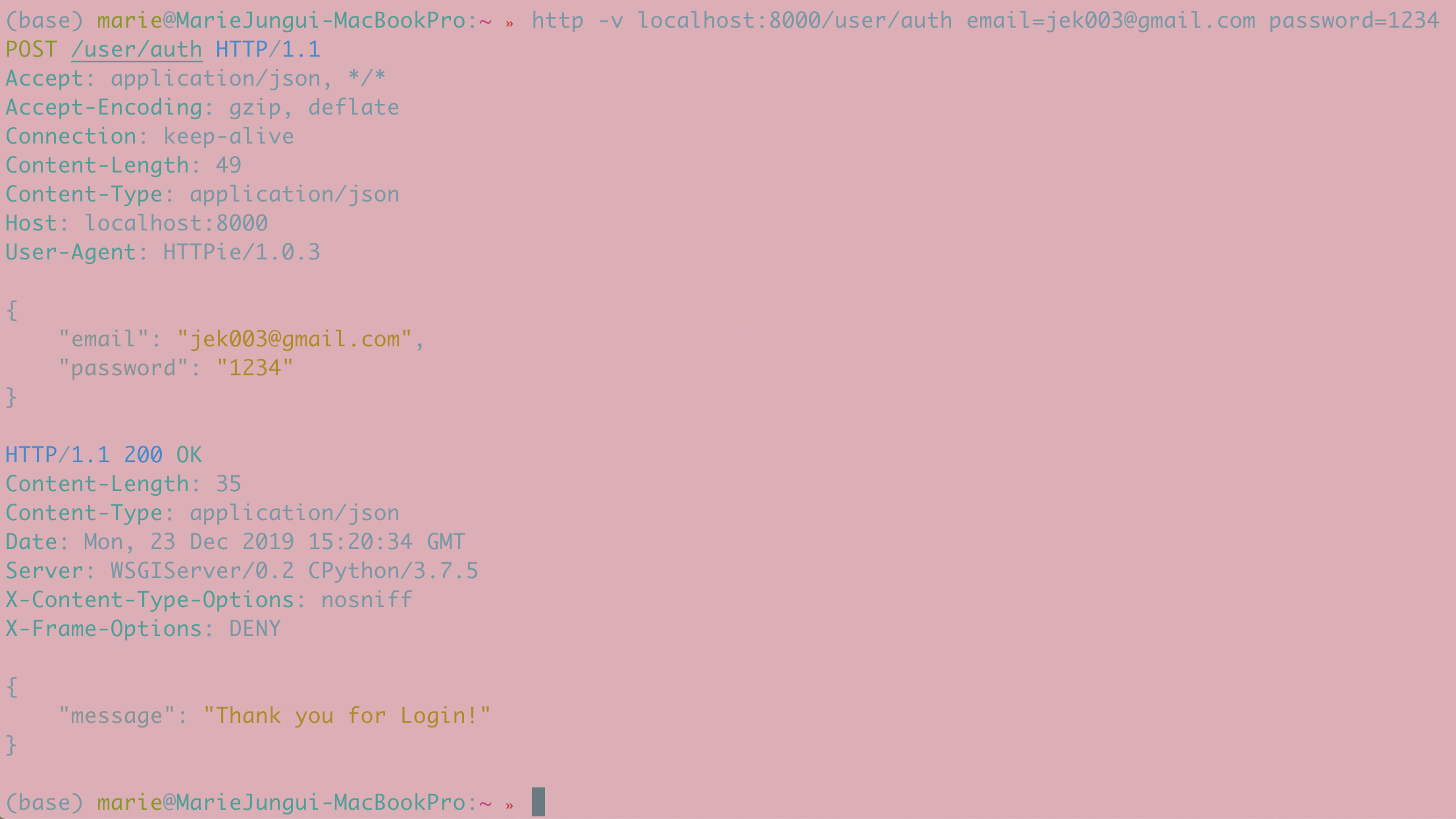1) 장고디렉터리의 urls.py 내용 수정하기
장고서버가 실행되면 무조건
장고디렉터리의 urls.py를 바라보게 되어있어요.
그런데 그 urls.py에는 아직 "user"라는 우리가 만든 app의 경로가 없어요.
그래서 추가할게요!
(test_project) marie@MarieJungui-MacBookPro:~/mynewdjango »
(test_project) marie@MarieJungui-MacBookPro:~/mynewdjango » pwd
/Users/marie/mynewdjango
(test_project) marie@MarieJungui-MacBookPro:~/mynewdjango » tree
.
├── db.sqlite3
├── manage.py
├── mynewjangodirec
│ ├── __init__.py
│ ├── __pycache__
│ │ ├── __init__.cpython-37.pyc
│ │ ├── settings.cpython-37.pyc
│ │ ├── urls.cpython-37.pyc
│ │ └── wsgi.cpython-37.pyc
│ ├── asgi.py
│ ├── settings.py
│ ├── urls.py
│ └── wsgi.py
└── user
├── __init__.py
├── __pycache__
│ ├── __init__.cpython-37.pyc
│ ├── admin.cpython-37.pyc
│ └── models.cpython-37.pyc
├── admin.py
├── apps.py
├── migrations
│ ├── 0001_initial.py
│ ├── __init__.py
│ └── __pycache__
│ ├── 0001_initial.cpython-37.pyc
│ └── __init__.cpython-37.pyc
├── models.py
├── tests.py
├── urls.py
└── views.py
"""mynewjangodirec URL Configuration
6 directories, 25 files
(test_project) marie@MarieJungui-MacBookPro:~/mynewdjango »
(test_project) marie@MarieJungui-MacBookPro:~/mynewdjango » cat ./mynewjangodirec/urls.py
"""mynewjangodirec URL Configuration
The `urlpatterns` list routes URLs to views. For more information please see:
https://docs.djangoproject.com/en/3.0/topics/http/urls/
Examples:
Function views
1. Add an import: from my_app import views
2. Add a URL to urlpatterns: path('', views.home, name='home')
Class-based views
1. Add an import: from other_app.views import Home
2. Add a URL to urlpatterns: path('', Home.as_view(), name='home')
Including another URLconf
1. Import the include() function: from django.urls import include, path
2. Add a URL to urlpatterns: path('blog/', include('blog.urls'))
"""
from django.contrib import admin
from django.urls import path
urlpatterns = [
path('admin/', admin.site.urls),
]
(test_project) marie@MarieJungui-MacBookPro:~/mynewdjango »
(test_project) marie@MarieJungui-MacBookPro:~/mynewdjango » vi ./mynewjangodirec/urls.py
(test_project) marie@MarieJungui-MacBookPro:~/mynewdjango »
(test_project) marie@MarieJungui-MacBookPro:~/mynewdjango » cat ./mynewjangodirec/urls.py 1 ↵
"""mynewjangodirec URL Configuration
The `urlpatterns` list routes URLs to views. For more information please see:
https://docs.djangoproject.com/en/3.0/topics/http/urls/
Examples:
Function views
1. Add an import: from my_app import views
2. Add a URL to urlpatterns: path('', views.home, name='home')
Class-based views
1. Add an import: from other_app.views import Home
2. Add a URL to urlpatterns: path('', Home.as_view(), name='home')
Including another URLconf
1. Import the include() function: from django.urls import include, path
2. Add a URL to urlpatterns: path('blog/', include('blog.urls'))
"""
from django.contrib import admin
from django.urls import path, include
urlpatterns = [
path('admin/', admin.site.urls),
path('user',include('user.urls') ), # "user"라는 url은 user파일 하단의 "urls"파일로 토스~
]
(test_project) marie@MarieJungui-MacBookPro:~/mynewdjango »2) 장고 서버실행하기
python manage.py runserver
2-에러1) 어머! url 관련 에러가 생겼어요!

[url의 "/" 자동생성 기능 disable하기]
(test_project) marie@MarieJungui-MacBookPro:~/mynewdjango »
(test_project) marie@MarieJungui-MacBookPro:~/mynewdjango » cat ./mynewjangodirec/settings.py
"""
Django settings for mynewjangodirec project.
Generated by 'django-admin startproject' using Django 3.0.1.
For more information on this file, see
https://docs.djangoproject.com/en/3.0/topics/settings/
For the full list of settings and their values, see
https://docs.djangoproject.com/en/3.0/ref/settings/
"""
import os
# Build paths inside the project like this: os.path.join(BASE_DIR, ...)
BASE_DIR = os.path.dirname(os.path.dirname(os.path.abspath(__file__)))
# Quick-start development settings - unsuitable for production
# See https://docs.djangoproject.com/en/3.0/howto/deployment/checklist/
# SECURITY WARNING: keep the secret key used in production secret!
SECRET_KEY = 'u8(7%^1zs80hb(93lyxg_+s=+a12b465m^*lk4e$8bar4v&oll'
# SECURITY WARNING: don't run with debug turned on in production!
DEBUG = True
ALLOWED_HOSTS = []
# Application definition
INSTALLED_APPS = [
'django.contrib.admin',
'django.contrib.auth',
'django.contrib.contenttypes',
'django.contrib.sessions',
'django.contrib.messages',
'django.contrib.staticfiles',
'user',
]
MIDDLEWARE = [
'django.middleware.security.SecurityMiddleware',
'django.contrib.sessions.middleware.SessionMiddleware',
'django.middleware.common.CommonMiddleware',
'django.middleware.csrf.CsrfViewMiddleware',
'django.contrib.auth.middleware.AuthenticationMiddleware',
'django.contrib.messages.middleware.MessageMiddleware',
'django.middleware.clickjacking.XFrameOptionsMiddleware',
]
ROOT_URLCONF = 'mynewjangodirec.urls'
TEMPLATES = [
{
'BACKEND': 'django.template.backends.django.DjangoTemplates',
'DIRS': [],
'APP_DIRS': True,
'OPTIONS': {
'context_processors': [
'django.template.context_processors.debug',
'django.template.context_processors.request',
'django.contrib.auth.context_processors.auth',
'django.contrib.messages.context_processors.messages',
],
},
},
]
WSGI_APPLICATION = 'mynewjangodirec.wsgi.application'
# Database
# https://docs.djangoproject.com/en/3.0/ref/settings/#databases
DATABASES = {
'default': {
'ENGINE': 'django.db.backends.sqlite3',
'NAME': os.path.join(BASE_DIR, 'db.sqlite3'),
}
}
# Password validation
# https://docs.djangoproject.com/en/3.0/ref/settings/#auth-password-validators
AUTH_PASSWORD_VALIDATORS = [
{
'NAME': 'django.contrib.auth.password_validation.UserAttributeSimilarityValidator',
},
{
'NAME': 'django.contrib.auth.password_validation.MinimumLengthValidator',
},
{
'NAME': 'django.contrib.auth.password_validation.CommonPasswordValidator',
},
'NAME': 'django.contrib.auth.password_validation.NumericPasswordValidator',
{
'NAME': 'django.contrib.auth.password_validation.NumericPasswordValidator',
},
]
# Internationalization
# https://docs.djangoproject.com/en/3.0/topics/i18n/
LANGUAGE_CODE = 'en-us'
TIME_ZONE = 'UTC'
USE_I18N = True
USE_L10N = True
USE_TZ = True
# Static files (CSS, JavaScript, Images)
# https://docs.djangoproject.com/en/3.0/howto/static-files/
STATIC_URL = '/static/'
(test_project) marie@MarieJungui-MacBookPro:~/mynewdjango »
(test_project) marie@MarieJungui-MacBookPro:~/mynewdjango » vi ./mynewjangodirec/settings.py
(test_project) marie@MarieJungui-MacBookPro:~/mynewdjango »
(test_project) marie@MarieJungui-MacBookPro:~/mynewdjango » cat ./mynewjangodirec/settings.py
"""
Django settings for mynewjangodirec project.
Generated by 'django-admin startproject' using Django 3.0.1.
For more information on this file, see
https://docs.djangoproject.com/en/3.0/topics/settings/
For the full list of settings and their values, see
https://docs.djangoproject.com/en/3.0/ref/settings/
"""
import os
# Build paths inside the project like this: os.path.join(BASE_DIR, ...)
BASE_DIR = os.path.dirname(os.path.dirname(os.path.abspath(__file__)))
# Quick-start development settings - unsuitable for production
# See https://docs.djangoproject.com/en/3.0/howto/deployment/checklist/
# SECURITY WARNING: keep the secret key used in production secret!
SECRET_KEY = 'u8(7%^1zs80hb(93lyxg_+s=+a12b465m^*lk4e$8bar4v&oll'
# SECURITY WARNING: don't run with debug turned on in production!
DEBUG = True
ALLOWED_HOSTS = []
# Application definition
INSTALLED_APPS = [
'django.contrib.admin',
'django.contrib.auth',
'django.contrib.contenttypes',
'django.contrib.sessions',
'django.contrib.messages',
'django.contrib.staticfiles',
'user',
]
MIDDLEWARE = [
'django.middleware.security.SecurityMiddleware',
'django.contrib.sessions.middleware.SessionMiddleware',
'django.middleware.common.CommonMiddleware',
'django.middleware.csrf.CsrfViewMiddleware',
'django.contrib.auth.middleware.AuthenticationMiddleware',
'django.contrib.messages.middleware.MessageMiddleware',
'django.middleware.clickjacking.XFrameOptionsMiddleware',
]
ROOT_URLCONF = 'mynewjangodirec.urls'
TEMPLATES = [
{
'BACKEND': 'django.template.backends.django.DjangoTemplates',
'DIRS': [],
'APP_DIRS': True,
'OPTIONS': {
'context_processors': [
'django.template.context_processors.debug',
'django.template.context_processors.request',
'django.contrib.auth.context_processors.auth',
'django.contrib.messages.context_processors.messages',
],
},
},
]
WSGI_APPLICATION = 'mynewjangodirec.wsgi.application'
# Database
# https://docs.djangoproject.com/en/3.0/ref/settings/#databases
DATABASES = {
'default': {
'ENGINE': 'django.db.backends.sqlite3',
'NAME': os.path.join(BASE_DIR, 'db.sqlite3'),
}
}
# Password validation
# https://docs.djangoproject.com/en/3.0/ref/settings/#auth-password-validators
AUTH_PASSWORD_VALIDATORS = [
{
'NAME': 'django.contrib.auth.password_validation.UserAttributeSimilarityValidator',
},
{
'NAME': 'django.contrib.auth.password_validation.MinimumLengthValidator',
},
{
'NAME': 'django.contrib.auth.password_validation.CommonPasswordValidator',
},
{
'NAME': 'django.contrib.auth.password_validation.NumericPasswordValidator',
},
]
# Internationalization
# https://docs.djangoproject.com/en/3.0/topics/i18n/
LANGUAGE_CODE = 'en-us'
TIME_ZONE = 'UTC'
USE_I18N = True
USE_L10N = True
USE_TZ = True
# Static files (CSS, JavaScript, Images)
# https://docs.djangoproject.com/en/3.0/howto/static-files/
STATIC_URL = '/static/'
##Disable_slash
APPEND_SLASH = False
(test_project) marie@MarieJungui-MacBookPro:~/mynewdjango »2-에러2) 어머! CSRF 관련 에러가 생겼어요!


[장고의 디폴트기능인 CSRF기능 disable하기]
(test_project) marie@MarieJungui-MacBookPro:~/mynewdjango » cat ./mynewjangodirec/settings.py
"""
Django settings for mynewjangodirec project.
Generated by 'django-admin startproject' using Django 3.0.1.
For more information on this file, see
https://docs.djangoproject.com/en/3.0/topics/settings/
For the full list of settings and their values, see
https://docs.djangoproject.com/en/3.0/ref/settings/
"""
import os
# Build paths inside the project like this: os.path.join(BASE_DIR, ...)
BASE_DIR = os.path.dirname(os.path.dirname(os.path.abspath(__file__)))
# Quick-start development settings - unsuitable for production
# See https://docs.djangoproject.com/en/3.0/howto/deployment/checklist/
# SECURITY WARNING: keep the secret key used in production secret!
SECRET_KEY = 'u8(7%^1zs80hb(93lyxg_+s=+a12b465m^*lk4e$8bar4v&oll'
# SECURITY WARNING: don't run with debug turned on in production!
DEBUG = True
ALLOWED_HOSTS = []
# Application definition
INSTALLED_APPS = [
#'django.contrib.admin',
#'django.contrib.auth',
'django.contrib.contenttypes',
'django.contrib.sessions',
'django.contrib.messages',
'django.contrib.staticfiles',
'user',
]
MIDDLEWARE = [
'django.middleware.security.SecurityMiddleware',
'django.contrib.sessions.middleware.SessionMiddleware',
'django.middleware.common.CommonMiddleware',
#'django.middleware.csrf.CsrfViewMiddleware',
#'django.contrib.auth.middleware.AuthenticationMiddleware',
'django.contrib.messages.middleware.MessageMiddleware',
'django.middleware.clickjacking.XFrameOptionsMiddleware',
]
ROOT_URLCONF = 'mynewjangodirec.urls'
TEMPLATES = [
{
'BACKEND': 'django.template.backends.django.DjangoTemplates',
'DIRS': [],
'APP_DIRS': True,
'OPTIONS': {
'context_processors': [
'django.template.context_processors.debug',
'django.template.context_processors.request',
'django.contrib.auth.context_processors.auth',
'django.contrib.messages.context_processors.messages',
],
},
},
]
WSGI_APPLICATION = 'mynewjangodirec.wsgi.application'
# Database
# https://docs.djangoproject.com/en/3.0/ref/settings/#databases
DATABASES = {
'default': {
'ENGINE': 'django.db.backends.sqlite3',
'NAME': os.path.join(BASE_DIR, 'db.sqlite3'),
}
}
# Password validation
# https://docs.djangoproject.com/en/3.0/ref/settings/#auth-password-validators
AUTH_PASSWORD_VALIDATORS = [
{
'NAME': 'django.contrib.auth.password_validation.UserAttributeSimilarityValidator',
},
{
'NAME': 'django.contrib.auth.password_validation.MinimumLengthValidator',
},
{
'NAME': 'django.contrib.auth.password_validation.CommonPasswordValidator',
},
{
'NAME': 'django.contrib.auth.password_validation.NumericPasswordValidator',
},
]
# Internationalization
# https://docs.djangoproject.com/en/3.0/topics/i18n/
LANGUAGE_CODE = 'en-us'
TIME_ZONE = 'UTC'
USE_I18N = True
USE_L10N = True
USE_TZ = True
# Static files (CSS, JavaScript, Images)
# https://docs.djangoproject.com/en/3.0/howto/static-files/
STATIC_URL = '/static/'
##Disable_slash
APPEND_SLASH = False
(test_project) marie@MarieJungui-MacBookPro:~/mynewdjango »2) http -v 이용해서 http post 해보기
[user 가입하기]
(base) marie@MarieJungui-MacBookPro:~ » http -v localhost:8000/user name=jek003 email=jek003@gmail.com password=1234
POST /user HTTP/1.1
Accept: application/json, */*
Accept-Encoding: gzip, deflate
Connection: keep-alive
Content-Length: 67
Content-Type: application/json
Host: localhost:8000
User-Agent: HTTPie/1.0.3
{
"email": "jek003@gmail.com",
"name": "jek003",
"password": "1234"
}
HTTP/1.1 200 OK
Content-Length: 28
Content-Type: application/json
Date: Mon, 23 Dec 2019 14:10:33 GMT
Server: WSGIServer/0.2 CPython/3.7.5
X-Content-Type-Options: nosniff
X-Frame-Options: DENY
{
"message": "It's success!"
}
(base) marie@MarieJungui-MacBookPro:~ »
[user 로그인하기 성공!]


[urls.py 정보 더블체크]
(test_project) marie@MarieJungui-MacBookPro:~/mynewdjango » cat ./mynewjangodirec/urls.py
"""mynewjangodirec URL Configuration
The `urlpatterns` list routes URLs to views. For more information please see:
https://docs.djangoproject.com/en/3.0/topics/http/urls/
Examples:
Function views
1. Add an import: from my_app import views
2. Add a URL to urlpatterns: path('', views.home, name='home')
Class-based views
1. Add an import: from other_app.views import Home
2. Add a URL to urlpatterns: path('', Home.as_view(), name='home')
Including another URLconf
1. Import the include() function: from django.urls import include, path
2. Add a URL to urlpatterns: path('blog/', include('blog.urls'))
"""
#from django.contrib import admin
from django.urls import path, include
urlpatterns = [
# path('admin/', admin.site.urls),
path('user',include('user.urls') ), # "user"라는 url은 user파일 하단의 "urls"파일로 토스!
]
(test_project) marie@MarieJungui-MacBookPro:~/mynewdjango »
(test_project) marie@MarieJungui-MacBookPro:~/mynewdjango » cat ./user/urls.py
"""mynewjangodirec URL Configuration
The `urlpatterns` list routes URLs to views. For more information please see:
https://docs.djangoproject.com/en/3.0/topics/http/urls/
Examples:
Function views
1. Add an import: from my_app import views
2. Add a URL to urlpatterns: path('', views.home, name='home')
Class-based views
1. Add an import: from other_app.views import Home
2. Add a URL to urlpatterns: path('', Home.as_view(), name='home')
Including another URLconf
1. Import the include() function: from django.urls import include, path
2. Add a URL to urlpatterns: path('blog/', include('blog.urls'))
"""
from django.urls import path
from .views import UserView, AuthView #이 파일(urls.py)이 위치한 디렉터리의 views.py파일에서 클래스 UserViewdhk 클래스 AuthView를 import!
urlpatterns = [
path('', UserView.as_view()), #".as_view()"는 진입메소드로! http 메소드(get,post)를 알아내는 dispatch() 메소드를 호출한다
path('/auth', AuthView.as_view()),
]
(test_project) marie@MarieJungui-MacBookPro:~/mynewdjango »